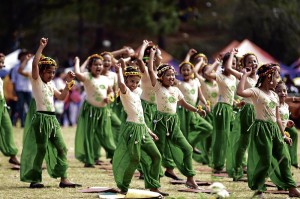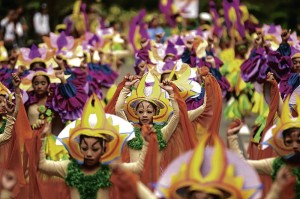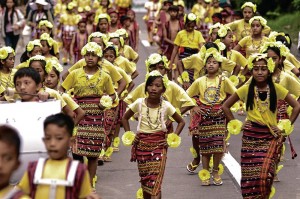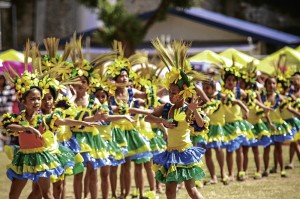Time for Baguio to cash in on flower festival
BAGUIO CITY—When the Panagbenga, or the Baguio Flower Festival, was started in 1996, it was designed to bring back business to a city ravaged by the 1990 earthquake.
Now 17 years later, the Cordillera-inspired street dancing and floral float parades have given Baguio its biggest economic boost.
In 2012, Mayor Mauricio Domogan attributed a sudden rise in business taxes of P170 million to gross revenues from the 17th staging of the flower festival.
But for this year, the city government began looking into new ways that would make the festival more efficient without nullifying its economic impact.
Domogan said that the local government is mulling over a 2-percent sales tax for businesses that profit from the festival and other tourism activities to augment government resources to

STUDENTS in attractive costumes take part in a showdown at the Burnham Park Athletic Bowl in Baguio City during the 2013 Panagbenga Flower Festival.
manage garbage disposal, improve water harvesting and maintenance of aquifers, and to sustain security.
Since the last decade, Baguio groups have become concerned over the festival’s enormous allure and its impact on traffic, garbage, and a community that has lived with a rationed water supply since the 1980s.
Frederico Alquiros, festival chair, said he was certain last year’s month-long staging of Panagbenga exceeded a million visitors, based on records of commercial bus trips to the city.
But organizers do not intend to breach that figure any further, which is estimated to be a 20-percent increase in Baguio’s daytime population of over 400,000, he said.
“Baguio would explode from tourist overflow,” Alquiros said.
Domogan said the government has been considering some housekeeping to make the festival more efficient and financially beneficial to the community.
For example, the city council is also considering an amendment to its newly updated ordinance banning trade fairs from operating in public parks and exempt Panagbenga activities that are mounted at Burnham Park, a favorite tourist destination.
The festival still operates using a P2-million subsidy from the city government and up to P8 million in funds offered by business sponsors.
“When I started this in 1996, we only [worked with] P1 million in nine days,” said lawyer Damaso Bangaoet Jr., former president of the John Hay Poro Point Development Corp. and the man considered as the “Father of Panagbenga” for initiating the festival.
Anthony de Leon, general manager of the Baguio Country Club and the festival’s former chair, said sponsorship was not difficult because telecommunications companies spent up to P6 million for the festival each year until 2006. The recent festivals had operated using half a million pesos donated by the same firms, he said.
PHOTOS BY RICHARD BALONGLONG AND EV


